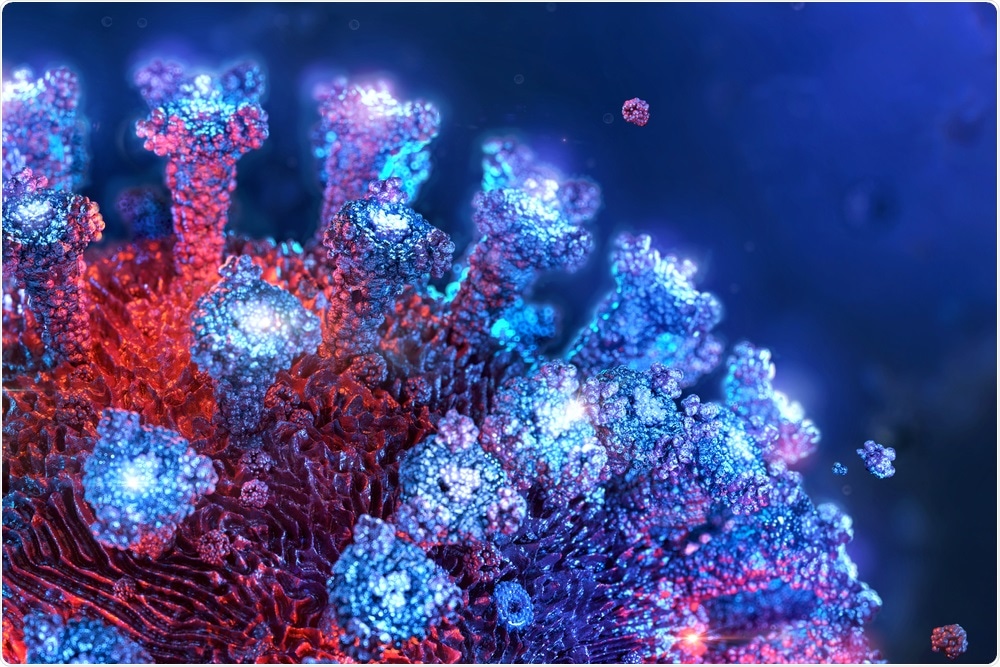Coronaviruses are a family of positive-strand ribonucleic acid (+RNA) viruses that infect a wide range of hosts. Some strains that infect humans, such as the human coronavirus (HCoV) which is responsible for the common cold, mainly result in mild, self-limiting disease.
However, there are now three coronaviruses that are much more pathogenic and cause higher mortality rates. The Middle East respiratory syndrome coronavirus (MERS-CoV) and severe acute respiratory syndrome coronavirus (SARS-CoV) were the most profound zoonotic coronaviruses until the emergence of severe acute respiratory syndrome coronavirus 2 (SARS-CoV-2) in 2019.
 Study: Coronavirus RNA synthesis takes place within membrane-bound sites. Image Credit: Corona Borealis Studio / Shutterstock.com
Study: Coronavirus RNA synthesis takes place within membrane-bound sites. Image Credit: Corona Borealis Studio / Shutterstock.com
Background
Viruses are defined as obligate intracellular parasites that rely on host cells to provide cellular machinery for viral replication. All +RNA viruses induce the rearrangement of host cell intracellular membranes to form replication organelles (ROs). In recent years, the possible production of antiviral therapies that target ROs has increased attention to this specific part of the viral life cycle.
Infectious bronchitis virus (IBV), which is a gamma coronavirus, is of economic importance to the poultry industry. IBV causes reduced egg production, reduced egg quality, and has a significant impact on animal welfare.
Recent studies have elucidated the role that ROs play in viral RNA synthesis and have suggested a possible pathway for newly synthesized RNA to leave double-membrane vesicles (DMV) through a molecular pore. However, there is no conclusive evidence to support this hypothesis.
To this end, in a recent study published on the preprint server bioRxiv*, a team of researchers show that IBV viral RNA synthesis occurs within the membrane-bound compartment. Here, the authors also demonstrate that this process is conserved across all four genera of the coronavirus family.
About the study
Previous research has shown that during the life cycle of IBV, the viral RNA-dependent RNA polymerase (RdRp) does not colocalize with double-stranded RNA (dsRNA). In SARS-CoV, it has been shown that the dsRNA found within DMVs is hidden to prevent detection by intracellular recognition receptors.
.jpg)
Within +RNA families, the formation of dsRNA is well conserved. Therefore, the authors sought to evaluate if dsRNA is protected within membrane-bound compartments in IBV infection using different permeabilization agents.
The authors used mock-infected DF1 cells permeabilized with either digitonin or TX100, then labeled the cells with antibodies specific for protein disulfide isomerase (PDI) and tubulin. Cells permeabilized with TX100 displayed both RdRp and dsRNA labeling, with the labeling of dsRNA increasing as the infection progressed. However, the digitonin permeabilized cells displayed no visible dsRNA, which indicates that it is stored within the intracellular membrane and cannot be accessed by the antibody.
To determine what occurs with early infection synthesized RNA and whether viral RNA produced within membrane-bound compartments is translocated to the cytoplasm, the authors exposed cells to labeled uridine in the form of bromouridine (pulse) and unlabeled uridine (chase). At eight hours post-infection (HPI), the viral RNA was observed to be situated in the cytoplasmic puncta. When the viral RNA was observed 24 HPI, it appeared situated in large cytoplasmic puncta, as well as diffused within the cytoplasm.
.jpg)
Across all genera of coronaviruses, the structure of ROs appears to be well conserved; however, there are some morphological differences between the viruses. Within Alpha and Beta coronaviruses, convoluted membranes are widely found, whereas Delta and Gamma coronaviruses do not exhibit the same degree of convolution in their membranes. With Alpha and Beta coronaviruses, the spherules were found to be associated with the cytoplasm with the majority sealed within compartments, whereas the spherules in Gamma coronaviruses remain open to the cytosol.
Therefore, the authors sought to understand if there were any differences between where RNA synthesized in IBV compared to other coronaviruses. To conduct this analysis, the authors utilized HCoV 229E, Alpha-CoV, Beta-CoV, and Delta-CoV and labeled the locations of nascent RNA. The same aforementioned permeabilization procedures were then performed, followed by the labeling of cells to detect bromouridine labeled nascent RNA or the viral nucleocapsid (N).
Regardless of the permeabilization method, the N labeling for each virus diffused throughout the cytoplasm, whereas the bromouridine labeling was contained within a membrane-bound compartment for HCoV 229E, Beta-CoV, and Delta-CoV. This is consistent with what was seen for IBV and exhibits a conserved mechanism across the coronavirus family.
Implications
The coronavirus family is comprised of many pathogens that infect both animals and humans. The ROs from all four genera of coronaviruses are comprised of DMVs and double-membrane spherules.
In this study, the authors investigated the site of viral RNA synthesis of one virus from each coronavirus genus. Of the viruses investigated, the RNA synthesis site was bound within a membrane that is located on the interior of DMVs.
It remains unclear the role of coronavirus-induced convoluted membranes, double-membrane spherules, and zippered endoplasmic reticulum. However, the understanding that all coronaviruses synthesize viral RNA within a membrane-bound compartment is a significant step in deciphering the replication process of the coronavirus family.
*Important notice
bioRxiv publishes preliminary scientific reports that are not peer-reviewed and, therefore, should not be regarded as conclusive, guide clinical practice/health-related behavior, or treated as established information.
- Doyle, N., Simpson, J., Hawes, P. C., & Maier, H. (2021). Coronavirus RNA synthesis takes place within membrane-bound sites. bioRxiv. doi:10.1101/2021.11.04.467246. https://www.biorxiv.org/content/10.1101/2021.11.04.467246v1
Posted in: Medical Science News | Medical Research News | Disease/Infection News
Tags: Antibodies, Antibody, Bronchitis, Cell, Cold, Common Cold, Coronavirus, Coronavirus Disease COVID-19, Cytoplasm, Double Membrane, Intracellular, Membrane, MERS-CoV, Mortality, Polymerase, Protein, Research, Respiratory, Ribonucleic Acid, RNA, SARS, SARS-CoV-2, Severe Acute Respiratory, Severe Acute Respiratory Syndrome, Syndrome, Virus
.jpg)
Written by
Colin Lightfoot
Colin graduated from the University of Chester with a B.Sc. in Biomedical Science in 2020. Since completing his undergraduate degree, he worked for NHS England as an Associate Practitioner, responsible for testing inpatients for COVID-19 on admission.
Source: Read Full Article
